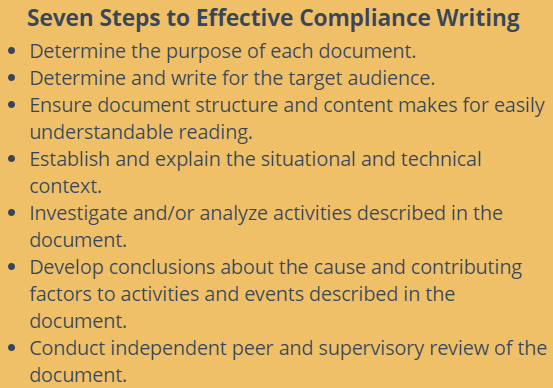Well-drafted, easy-to-understand quality records are crucial to helping pharmaceutical and medical device manufacturers navigate FDA inspection obstacles. The FDA relies heavily on information presented in inspection-implicated documents to determine whether a manufacturing operation is compliant with FDA’s requirements and expectations, as expressed (in theory) in a company’s own SOPs. But investigators won’t put in herculean efforts to try and figure out the purpose, meaning, actions or conclusions of reviewed documents, and therefore, it’s critically important that companies ensure that all inspection-implicated documents tell a good story about compliant operations.
While compliance writing — a specialized blend of technical, business and regulatory writing — is seldom emphasized in employee training or quality-related SOPs, good writing can mean the difference between a successful and an unsuccessful FDA inspection.
The challenge of writing helpful, inspection-ready documents begins with ensuring that each document has a clearly understood purpose and correctly targets the right audience (see Article 2), as well as structuring each document in a way that tells a compelling story of compliance, with technical and regulatory context provided and no plot holes to raise red flags with FDA investigators (see Article 3).
Certain documents create more risk than others, as well, in terms of potential adverse-inspection impact. Technical records such as validation protocols and results, documents detailing testing required under regulations, and reports of complaint-handling and CAPA (see example below) are among the documents most-often reviewed during inspections. They are also the documents most likely to result in a 483 observation or warning letter citation.
CAPA: The Most Important Story-Telling You Can Do
CAPA documents are among the most frequently reviewed and closely scrutinized during an FDA inspection. Deficient CAPAs are also among the most common observations in FDA 483s and citations in warning letters. Poorly written CAPA documents can derail an otherwise positive FDA inspection and lead to many additional questions and openings for Investigator concern in an inspection setting. However, problems with CAPA documentation can largely be avoided by a clear focus on the goals of each CAPA-related report. Like most other quality documentation, CAPA reports can best be considered as a story. A story where events occur; compliance process drives investigation; analysis results in learnings and actions; and conclusions communicate outcomes. Story structures are essential in quality and compliance communications because humans are hard-wired for processing information through stories. A compelling CAPA story will feature:
- Character and scene development (background and details of the incident requiring the initiation of the company’s CAPA);
- A conflict and associated rise in action (the company’s investigation into the root cause of and contributing factors to the incident);
- A crisis or other climax (the root cause analysis): and
- Resulting action and final resolution (the corrective and preventive action plan).
Investigations and Analysis to Support Conclusions
One of the most challenging problems associated with producing inspection-ready documents is how companies execute steps 4-6 (see sidebar above) of the Writing for Compliance® structured writing process. These steps help to ensure that all quality and compliance stories — especially CAPAs — follow a logical progression supported by pertinent facts and data. The FDA is not a fan of surprise endings or plot twists; this is one case where a predictable story line is much-preferred.
The fifth step of the structured writing process involves investigation and/or analysis of activities described in the document. It is important to understand the difference between an investigation — research to discover additional facts or gain additional information — and an analysis — evaluation of established data or information to discover interrelationships and meaning of its component parts. An investigation is used to determine what should have happened, what actually happened, the how and why of the event and how serious the event was in terms of regulatory compliance and patient risk. An analysis is used to establish whether actions taken were appropriate and proper; this is where risk-based principles and standards are incorporated.
In some cases, both activities may be required; in others, a company may need to decide whether an investigation or an analysis is warranted.
The sixth step of the Writing for Compliance® structured writing process is to develop conclusions about the cause and contributing factors in the context of the entire set of activities and events described in the document, along with proposing remedial or other improvement activities, if necessary. The conclusion represents the end of the compliance story and should clearly show that the stated document’s purpose has been achieved. In the conclusion, companies can re-emphasize important points and give the FDA investigator or other readers a summarized “takeaway” message, including actions taken or about to be taken to resolve any issues.
An independent review should be used to close out the writing process. Experienced, independent reviewers can perform both a peer and a supervisory review before a document is approved and finalized according to established procedures. This review should aim to replicate how an FDA investigator might read the document several months in the future, and should determine the following:
- That the writing mirrors the actions taken;
- That the actions mirror the applicable SOP(s);
- That the activities are both scientifically valid and procedurally compliant; and
- That there are no unanswered questions—or “plot holes” in the story—or conclusions lacking a basis.
While writing for compliance can be challenging, following the seven steps of the Writing for Compliance® structured writing process (see sidebar above), including thorough investigation and analysis of problems and resolutions and careful explanations of conclusions reached, can help regulated manufacturers surmount writing-related obstacles and glide easily through FDA inspections.

